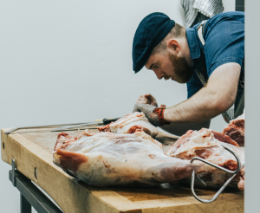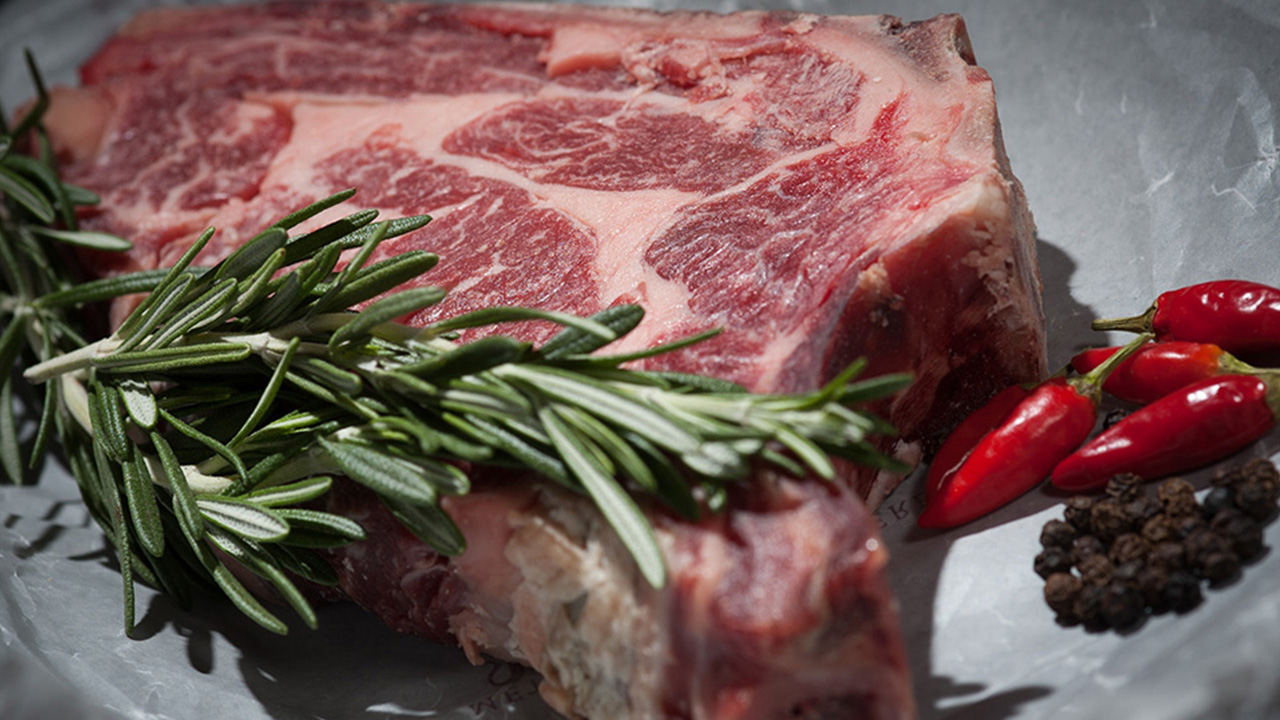Purveyors of high quality, locally sourced meat, we know a thing or two about preparing beef. Our master butchers are highly skilled in the art of meat cutting, preparing on a daily basis the various cuts we have become synonymous with.
You would be forgiven for thinking that our beef is passed on to our butchery team immediately after slaughter. In fact, there’s a crucial ‘in-between stage’ that gives our beef its distinctive taste, texture and mouth-watering flavour.
Prior to the cutting stage, we allow our beef to hang and mature naturally for up to 28 days, in a process known as dry aging.
How to Dry Age Beef –
Dry aging is the process of aging beef for weeks or months at a time prior to being cut. The process of dry aging dates back to the 1950s, when butchers discovered that aging meat in this fashion resulted in a product that was not only more tender, but in a class of its own in terms of flavour.
During the maturing process, the meat slowly loses moisture which adds to the taste; at the same time natural enzymes start to break-down connective tissue making it more tender.
There is no hard and fast rule in terms of how long you should allow meet to age – some of the most expensive cuts of beef you can find are aged for up to 4 months before being cut.
At Douglas Willis, we find that 28 days is sufficient…
What Happens to Beef When it is Dry Aged? –
As already alluded to, a number of changes occur that transform the meat’s structure:
- Moisture loss: a major contributing factor to the aging process, beef can lose up to 30% of its volume through the loss of water, which occurs mostly in the outer layers of the meat. In some cases, so much water is lost from the outer layers that they need to be trimmed before use. It therefore stands to reason that large pieces of meat produce bigger yields.
- Tenderisation: dry-aged beef is noticeably more tender than fresh beef. This is due to natural enzymes already present in the meat that act together to break down muscle fibre and connective tissue.
- Flavour Change: you can normally tell dry-aged beef apart from fresh by the aromas it produces, which are typically nutty or cheese-like. As with the tenderisation process, the change in flavour is down to bacteria, enzyme breakdown and oxidation.
It is worth mentioning at this stage that dry-aging occurs in specially constructed storage spaces, designed to carefully control the temperature and humidity levels within, as-well as the presence of naturally occurring bacteria which are integral to the process.
The dry-aging process in days –
This is what happens to beef during the dry-aging process over a 120-day period, which should give you an idea of the extent that some producers will go to satisfy the tastes of the most discerning of meat eaters:
7 days – collagen begins to break down; the meat still has a bright colour at this stage;
21 days – after 3 weeks, the meat will have lost 10% of its weight. The meat will start to concave as it shrinks;
30 days – 30 days is the most requested age in steaks (at Douglas Willis, we find that the sweet-spot is 28 days). With 15% of its weight lost, the meat is very tender at this stage and has begun to develop the flavour and texture associated with dry-aged beef;
45 days – after 45 days, white striations (a mixture of mold and salt) will begin to form in the meat. Only a bit more weight is lost at this stage;
90 days – the white striations start to develop into a crust, which acts to protect the meat;
120 days – after 120 days, 35% of the meat’s weight will have been lost. The meat will have an intense beef flavour at this stage. Meat aged for this long will be very expensive and sold only by a handful of restaurants.
Is Dry-Aged Beef more expensive than Fresh?
In a nutshell, yes. The costs associated with operating large, commercial dry aging facilities, combined with the amount of trimming required due to moisture loss, radically affects the cost of the end product, enabling suppliers and restaurant owners to charge a premium.
What is the Difference Between Dry-Aged & Wet-Aged Beef?
In essence, when meat is wet-aged, the moisture is retained. The dominant beef-ageing method in both the UK and the USA, wet aging is achieved by placing meat in vacuum sealed bags before being shipped to market, in a process known as modified-atmosphere packaging (MAP).
Typically, the aging takes place in the 4-10 days between slaughter and sale, while the meat is in transit. Unsurprisingly, this process is popular with suppliers and retailers as it takes less time to obtain the meat; it also costs less.
Keen to try it for yourself? Head over to the beef section of our online store and make your selection!





